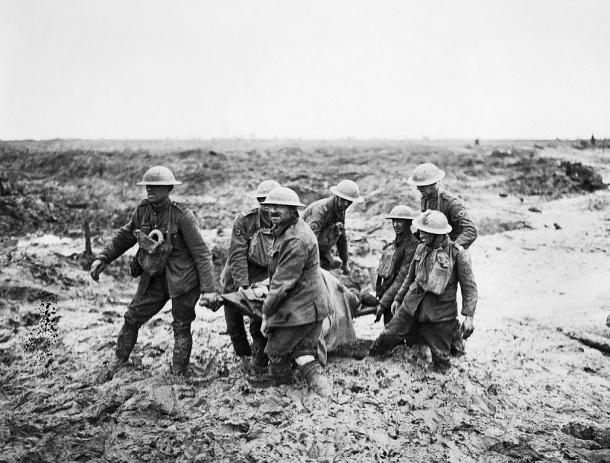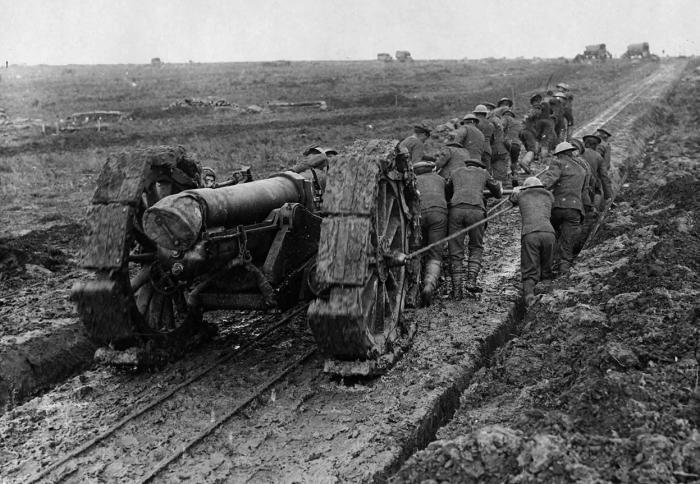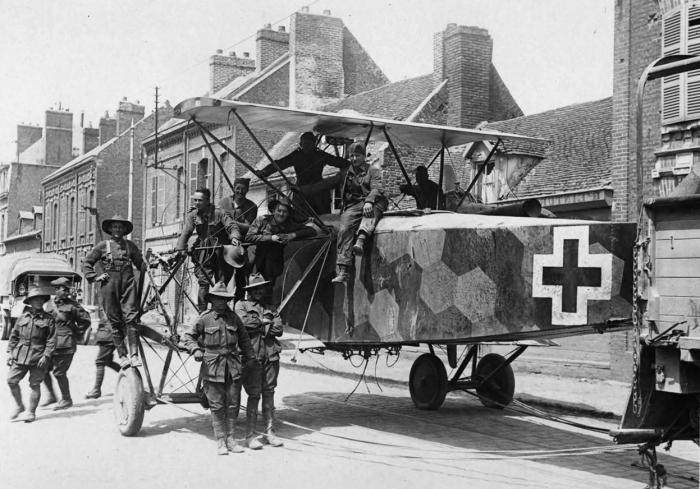Even before the war, it was safe to assume that the Western Front would take many lives. Two great civilizations came into contact here - French and German. In 1871, Bismarck took Alsace and Lorraine from Napoleon III. A new generation of neighbors longed for revenge.
German invasion
According to Schlieffen’s plan, the German forces were to strike quickly at their main rival in the region, France. In order to pave the way to Paris, it was planned to capture Luxembourg and Belgium. The tiny principality was occupied on August 2, 1914. It was on him that the first blow was made. The western front was open. Two days later, Belgium came under attack, which refused to let the aggressor through its territory.
The key battle of the first days of the war is the siege of the Liege fortress. She was a key crossing point across the Meuse River. The military operation took place from August 5 to 16. The defenders (36 thousand reservists) had at their disposal 12 forts and about 400 guns. The Maa army of attackers was almost 2 times larger (almost 60 thousand soldiers and officers).
The city was considered an impregnable fortress, but it fell as soon as the Germans brought up siege artillery (August 12). Following Liège, Brussels fell on August 20, and Namur fell on August 23. At the same time, the French army unsuccessfully tried to invade and gain a foothold in Alsace and Lorraine. The siege resulted in the implementation of a rapid offensive by German troops. At the same time, after the August fighting, it became clear that the old type of fortifications were not able to restrain troops equipped with weapons of the new - XX century.
Little Belgium was quickly left behind, and the fighting moved to the border with France, where the Western Front stopped. 1914 is also a series of battles at the end of August (Ardennes operation, the battles of Charleroi and Mons). The total number of troops on both sides exceeded 2 million. Despite the fact that several British divisions helped the French 5th Army, the Kaiser troops reached the Marne River by September 5.
Battle of the Marne
The plans of the Berlin command was the environment of Paris. This goal seemed achievable, because in the first days of September, individual detachments were already at a distance of 40 kilometers from the French capital. In that 1914, the Western Front seemed the forge of the unconditional success of the Kaiser and his General Staff.
It was at that moment that the Entente forces launched a counterattack. The battles spanned a vast area. At a critical moment, the Moroccan division arrived to help the French. The soldiers arrived not only by rail, but even by taxi. This was the first time in history when cars were massively used as vehicles in the war. Communications of the German army were stretched across Belgium, and replenishment in manpower ceased. In addition, the same 5th French army broke through the enemy’s defenses and went to the rear when many German soldiers were transferred to East Prussia, where Russia opened the North-Western Front. Seeing this situation, General Alexander von Kluk gave the order to retreat.

The soldiers of the Triple Alliance received a strong psychological blow. The irremovability of personnel led to the fact that sleeping privates were taken prisoner. However, France and England could not take advantage of their victory. The persecution was sluggish and slow. The Allies failed to cut off the fleeing opponents and fill in the gaps in their defense.
By October, active battles moved north, closer to the coast. Infantry on both sides tried to get around the enemy from the flank. Success was variable, until the end of the year no one could deliver a decisive blow. On Christmas Eve, some divisions unofficially agreed to cease fire. Each such case was called a "Christmas truce."
Trench warfare
After the events on the Marne, the Western Front of World War I changed the nature of the confrontation. Now the opponents strengthened their positions, and the war became positional throughout 1915. The blitzkrieg plan, which had previously been hatched in Berlin, failed.
Single attempts by the parties to move forward turned into disasters. So, after the attack in Champagne, the Allies lost at least 50 thousand people, advancing only half a kilometer. According to a similar scenario, the battle developed near the village of Nev-Chapelle, where the British lost more than 10 thousand soldiers, advancing only 2 kilometers. The western front of World War I turned into the largest meat grinder in history.

With the same success, the Germans marched forward. In April-May, the battle of Ypres was going on, which became tragically famous thanks to the use of poisonous gases. Unfinished for such a turn of events, the infantry died, thousands of losses. After the first attack on the battlefield, gas masks were urgently delivered, which helped to survive the reuse of gas weapons by the German army. In total, under Iprom, the Entente's losses amounted to 70 thousand people (the German Empire had half as much). The success of the offensive was limited and, despite massive casualties, the line of defense was never broken.
The fighting of the Western Front continued under Artois. Here the Allies tried to develop the offensive twice - in the spring and autumn. Both operations failed, not least due to the use of machine guns by the Reich.
Battle of Verdun
The upcoming spring of 1916 met the Western Front of World War I with large-scale military operations in the area of the city of Verdun. Unlike previous operations, a feature of the next plan of the German generals was the calculation of the attack on a narrow plot of land. By this time - after a series of bloody battles - the German army simply did not have sufficient resources to attack on a large area, as it was, for example, on the Marne in 1914.
An important part of the attack was shelling, destroying the fortified positions of subjects of the Third Republic. After the bombing, the destroyed fortifications were occupied by infantry. In addition, innovative weapons such as flamethrowers were used. With the start of the cast, the troops of the Triple Alliance received a strategic initiative.
At this time, Russia continued to harass its Northwest Front. In the midst of Verdun events, the Naroch operation began. The Russian army carried out a distracting maneuver in the area of the modern Minsk region, after which the Reich command decided to transfer part of the forces to the east, since in Berlin it was believed that a general offensive had begun there. This was a mistake, because Russia delivered its main blow in the direction of Austria-Hungary (Brusilovsky breakthrough).
One way or another, but a precedent has been created. The Western and Eastern Front simultaneously depleted the Kaiser armies. In October, after a series of local setbacks, the French units took up the positions they held in February before the start of the enemy offensive. Germany has not achieved any strategically important results. In total, losses on both sides reached more than 600 thousand people (about 300 thousand were killed).
Battle of the Somme
In July 1916, when the battles at Verdun dragged on, the Allied formations launched their own offensive on another section of the front. The operation on the Somme River began with artillery preparation, which lasted a whole week. After the systematic destruction of the enemy’s infrastructure, the infantry began their movement.
As it was before, in 1916 the Western Front was shaken by long and protracted battles. However, the events under the Somme were remembered in history by several features. Firstly, tanks were used here for the first time. They were invented by the British and were distinguished by technical imperfection: they quickly deteriorated and broke. Nevertheless, this did not prevent the new product from delivering a serious psychological blow to the enemy infantry. The rank and file ran in horror at the mere sight of an outlandish technique. Such success gave a serious impetus to the development of tank building. Secondly, aerial photography, which was carried out with the aim of reconnaissance of enemy positions, confirmed its advantage.

The fighting was exhausted and took a long-term character. By September, it became clear that Germany had no fresh strength. As a result, in the early days of autumn, the Allies advanced deep into enemy positions by several tens of kilometers. On September 25, heights were occupied that were of strategic importance in the region.
The western front of the First World War bleeding the German units, which already fought with several opponents alone. They lost important and fortified positions. Somme and Verdun led the Entente to seize strategic advantage and could now impose the course of the war on the Kaiser and his headquarters.
Hindenburg line
The vector of events was changing - the Western Front was rolling back. World War I entered a new phase. The imperial army was recalled beyond the Hindenburg line. It was a system of defensive structures of great length. It began to be erected during the events on the Somme according to the instructions of Paul von Hindenburg, in whose honor it was named. Field Marshal was transferred to France from the Eastern Theater of Action, where he successfully waged a war against the Russian Empire. His decisions were supported by another military leader, Erich Ludendorff, who in the future supported the Nazi party, which raised its head.
The line was built all winter 1916-1917. It was divided into 5 lines, which received the names of the characters of the Germanic epic. The western front of World War 1 was generally remembered for kilometers of trenches and barbed wire. The army was finally relocated in February 1917. The retreat was accompanied by the destruction of cities, roads and other infrastructure (scorched land tactics).
Nivelles offensive
What was the first World War I remembered for? The Western Front is a symbol of the meaninglessness of human sacrifice. The Nivelles meat grinder has become one of the biggest tragedies in the history of this conflict.
The operation on the side of the Entente involved more than 4 million people, while Germany had only 2.7 million. However, this advantage was not possible. Shortly before the start of the throw, the Germans captured a French soldier who had with him a written plan for the operation. So, it became known about the impending distraction, preparing the UK. As a result, its benefits were reduced to zero.
The offensive itself was choked, and the Allies could not break through the enemy’s defenses. Losses on both sides exceeded half a million people. After the failure in France, strikes and discontent among the population began.
It is also noteworthy that the Russian army took part in the notorious offensive. The Russian expeditionary force was formed specifically for shipment to Western Europe. After numerous losses in April-May 1917, he was disbanded, and the remaining soldiers were sent to a camp near Limoges. In the fall, soldiers who were in a foreign land rebelled, and after the October Revolution broke out, someone returned to the battlefields, others were in the rear of the enterprises, and still others went to Algeria and the Balkans. Subsequently, many officers returned to their homeland and died in the Civil War.
Paschendale and Cambrai
The summer of 1917 was marked by the third battle of Iprom, which is also known by the name of the small village of Pashendale. This time, the British command decided to break through the Western Front. World War I brought to mind the resources of numerous colonies of the Empire. It was here that units from Canada, Australia, New Zealand and South Africa fought. The expeditionary corps were the first to receive massive losses due to the use of new gas weapons by the enemy. It was mustard gas, or mustard gas, which affected the respiratory system, destroyed cells, disrupted the metabolism of carbohydrates in the body. Field Marshal Douglas Haig’s wards died in the thousands.
Affected by environmental conditions. Local swamps were buried under heavy rains, and had to move through impassable mud. The British lost a total of 500 thousand people killed and wounded. They managed to advance only a few kilometers. No one knew when World War 1 would end. The western front continued to blaze.
Another important British initiative was the offensive at Cambrai (November-December 1917), where tanks were used with unprecedented success. They managed to get past the Hindenburg line. However, the flip side of luck was the lag of the infantry and, as a result, the stretching of communications. The enemy took advantage of this by conducting a competent counterattack and pushing the British back to their original positions.
Campaign end
As in 1914, the Western Front practically did not change its location until the last months of the war. The situation remained stable right up to the moment when the power of the Bolsheviks was established in Russia, and Lenin decided to end the "imperialist war." The world was postponed several times due to the throwing of a delegation led by Trotsky, but after the next German attack, the treaty was nevertheless signed on March 3, 1918 in Brest. After that, 44 divisions were hurriedly transferred from the east.
And on March 21, the so-called Spring Offensive began, which was the last serious attempt of the army of William II to impose its course of the war. The result of several operations was the forcing of the Marne River. However, after the crossing they managed to advance only 6 kilometers, after which in July the Allies launched a decisive counterattack, called Stodnevny. Between August 8 and November 11, the Amiens and Saint-Mielle ledges were successively eliminated. In September, a general cast began from the North Sea to Verdun.
In Germany, an economic and humanitarian disaster began. Demoralized soldiers massively surrendered. The defeat was compounded by the fact that the United States joined the Entente. The American divisions were well trained and full of strength, unlike those who were on the other side of the trenches, which rolled back 80 kilometers. By November, the fighting was already in Belgium. On the 11th, a revolution took place in Berlin that destroyed the power of William. The new government entered into a truce. The fighting has stopped.
Summary
Officially, the war ended only on June 28, 1919, when the corresponding treaty was concluded in the Palace of Versailles. The authorities in Berlin have pledged to pay huge indemnities, give a tenth of the country's territory, and carry out demilitarization. For several years, the country's economy plunged into chaos. The brand has depreciated.
How many lives did World War I take? The Western Front has become a major battleground throughout the years of conflict. Several million people died on both sides, many were injured, shell-shocked, or lost their minds. The use of new weapons has depreciated human life as never before. Intelligence has received new technologies. The western front, the first strike on which was as terrible as the attacks after 4 years, remained an unhealed scar in European history. Despite the fact that bloody battles were fought in other regions, they did not have such strategic importance. It was on Belgian and French soil that the German army suffered the most serious losses.
These events were reflected in the culture: the books of Remarque, Junger, Aldington and others. Here served the young corporal Adolf Hitler. His generation was embittered by the unfair outcome of the war. This led to an increase in chauvinist sentiment in the Weimar Republic, the Nazis coming to power and the outbreak of World War II.